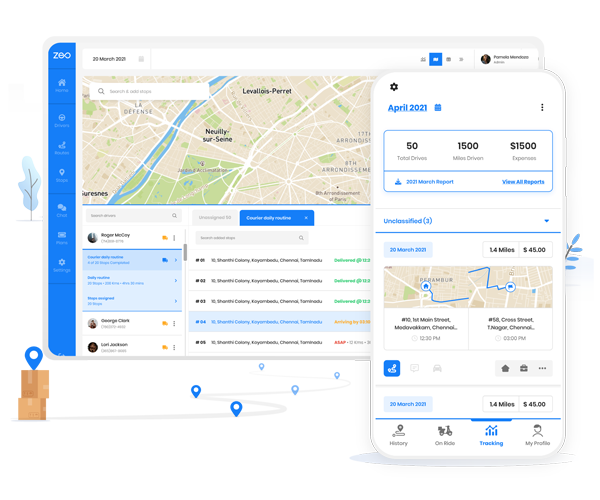Updated on: May 25, 2025
Building a route planner demands streamlining logistics, saving valuable time on the road, and delivering smooth experiences to operators and end customers. You may be managing deliveries, routing for sales visits, or even offering field support—a well-built route planner enables handling complex routing decisions in seconds.
With the Google Maps API, you can build a dynamic route with features that used to require entire engineering teams. It’s simple but has two major components: Google’s Place Autocomplete and the Routes API.
The Autocomplete API better the address input with intelligent suggestions, and the Routes API provides reliable navigation data with real-time traffic insights.
Here we’ll explore the steps you need to follow to build a route planner using the Routes API.
How To Create a Route Planner with Place Autocomplete and Routes API
A fully functional route planner is one that can accurately handle user input. One of which is to validate address suggestions in real time and calculate optimal paths with traffic considerations.
The below steps provide a quick snapshot of how you can use Google’s Place Autocomplete and Routes API to create a route planner.
- Set Up Your Google Maps Project
The basics: get a Google Cloud account and create a login.Next, start a project and enable specific APIs to render maps, suggest places as users type, and calculate optimal routes.
The three key APIs you need:
- Maps JavaScript API to embed and customize maps in your web interface.
- Places API for adding the Autocomplete feature so users can find addresses faster.
- Routes API for handling route computation, factoring in traffic, road conditions, and more.
You’ll also generate an API key and a secure password to access these services.
- Use Place Autocomplete for Accurate Inputs
Address entry is the first user interaction with any route planner. Since it is error-prone, Google’s Place
Autocomplete API provides location suggestions as the user types. It allows quick, error-free selections from the addresses.
How?
Through Google’s location intelligence, which shows only valid and geographically relevant options.
It detects user intent early, even from partial input, and narrows results based on session tokens, user geolocation, and country restrictions.
For example, typing “1 Mart” will immediately offer “1 Martin Place, NSW, Australia” as a top result if you’re in Australia.
To use Place Autocomplete in your planner:
- Enable the Places API in your Google Cloud Console project.
- Add the Maps JavaScript script tag with the Places library:
https://maps.googleapis.com/maps/api/js?key=YOUR_API_KEY&libraries=places - Create an address input field in your HTML so that users can type in locations.
- Initialize Autocomplete on that input field using JavaScript that enables API to return suggestions in real-time.
- Capture the selected place’s geometry (latitude and longitude), which are used later by the Routes API to compute directions.
- Calculate Routes Using the Routes API
Once you define your origin, destination, and any intermediate stops, Google’s Routes API generates a structured and optimized travel plan. It does not depend solely on live traffic data but intelligently organizes your stops for efficiency.
Now, this API can break each route into actionable elements—like total distance and estimated durations between points—with step-by-step directions.
increase fuel savings
Save $200 on fuel, Monthly!
Optimize routes with our algorithm, reducing travel time and costs efficiently.
Get Started for FreeDevelopers can specify the mode of travel (such as driving, bicycling, or walking), and the API supports the use of place IDs for pinpoint-accurate routing and consistency in location handling.
A broader-level working will work as follows:
- Start by providing the origin and destination addresses.
- Google Routes will calculate the route, distance, and estimated travel time while providing alternate paths.
- Visualize the route on your map interface or export it as part of your plan.
Ultimately, your delivery business can avail of efficient routing that saves time and operating costs. The smooth and easy workflow from address input to final navigation is possible this way with Place Autocomplete.
How Zeo Route Planner Acts as a Comprehensive Solution
You build a custom solution using Google APIs, but that requires you to hire developers or at least a team member with basic coding skills and knowledge of API management and ongoing maintenance.
That’s where Zeo Route Planner comes in. You dont need to work with the Routes API, instead start with a simple setup and leverage the benefits that you’d otherwise avail with Google Maps.
Built-in Place Autocomplete
Zeo Route Planner integrates the same Google-powered autocomplete technology within its platform. Thus, users can get real-time address suggestions when typing and don’t need to set up the Places API themselves.
So, it’s an ideal solution for
- Small businesses that add stops manually
- Drivers are making last-minute changes on the road
- Businesses looking to reduce the time to set up manual stops
Route Planning with No Coding
Zeo spares you from writing code for the routing logic or integrating APIs manually.
You get the same features and functionality as Google Routes by —
- Importing bulk addresses from spreadsheets
- Automatically optimizing routes with multiple constraints
- Updating and tracking routes in real-time
It offers a plug-and-play solution that takes the complexity out of building a route planner from scratch.
API Access for Developers
If you still need integrations, then you can benefit from Zeo’s powerful Route Optimization API which supports
- Custom route generation
- Real-time tracking updates
- Stop-level control and automation
Wrapping Up
If you’re building a route planner from scratch, Google’s Place Autocomplete and Routes API provides two good options. You have all the necessary tools like accurate address input, flexible route calculations, and a reliable foundation to scale your mapping features.
But, are you willing to spend time managing APIs, coding route logic, or handling ongoing updates? If not, you’re better off with the Zeo Route Planner, which has the same core functionality as autocomplete, stop optimization, and route tracking.
You can now book a demo and explore Zeo Route Planner to see how you can benefit from a custom-built tool without building it yourself.

Are you a fleet owner?
Want to manage your drivers and deliveries easily?
Grow your business effortlessly with Zeo Routes Planner – optimize routes and manage multiple drivers with ease.

increase fuel savings
Save 2 Hours on Deliveries, Everyday!
Optimize routes with our algorithm, reducing travel time and costs efficiently.
Get Started for Free
























